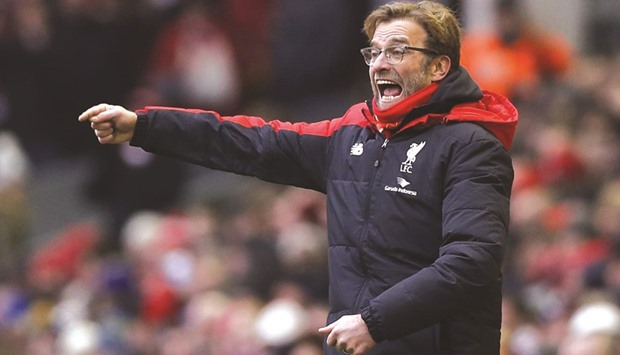Much has been made of Jürgen Klopp’s touchline behaviour at Liverpool, those sudden cartwheeling appearances, grasping at the air, forming weird geometric shapes with his hands, a blur of teeth, glasses and quilted sportswear. At first this was interpreted as “passion”, then anger, then provocation. Another thought occurred watching Klopp at Anfield on Sunday. Perhaps he’s just really, really confused.
And with good reason too. Liverpool’s squad is a deeply confusing collection of footballers. Watching their spirited impersonation of a coherent hard-pressing Premier League team, it was the final 10 minutes of the defeat by Manchester United that really stood out. Chasing a point at the last Klopp sent on Christian Benteke, the only centre-forward in his 18-man squad. Benteke touched the ball six times and visibly struggled to fit into a team that had just spent 80 minutes playing to an entirely different set of strengths.
With a minute to go Steven Caulker, a centre-half at centre-forward, came on for James Milner, a central midfielder playing as a right-side attacker, to join Roberto Firmino, a No9 or No10, who spent the 90 minutes haring about, quite effectively, trying to be both.
Little wonder Klopp might be a bit confused. And not just by the conflicting qualities of the group of players he has inherited. But by the structures and governance of a club that has, in a brilliant coup, managed to hire one of the most desirable managers in Europe; and then, in the opposite of a brilliant coup, presented him with one of the weirdest, most ill-fitting squads in recent Premier League history.
This is no exaggeration. Liverpool have signed 50 players in the past five years, a team a season. The current group were signed under five different managers, to unconnected tactical plans, most recently by a mob-handed transfer committee with its own dimly conceived moneyball-style pretentions.
There is no shortage of informed opinion on Klopp’s efforts to make sense of this. One thing stands out though. Liverpool’s transfer committee, in its current format, really does deserve to go.
The reasons for this are obvious enough. First, it is now basically redundant. It was Brendan Rodgers’ insistence that he wouldn’t work with a director of football that led to the committee’s formation in the first place. Odd to think that but for Rodgers’ stubbornness
Louis van Gaal might have been in the Liverpool directors’ box on Sunday, or even next to Klopp on the bench as one half of a mouthwatering Euro-brainbox power-couple.
Rodgers’ remarks about the workings of the club over the weekend must be read in the context of an unemployed manager tending his reputation. But they do shine a light on the self-generated muddle the club has handed his successor.
“It’s difficult because you want a player in but if the player is not on the list, you’d have to take someone,” Rodgers said, “There’s no other option, you give it a go.”
Except that giving it a go works only if there is a hint of a tactically sympathetic relationship with the man putting these players on the pitch. Of the team Liverpool fielded on Sunday Mamadou Sakho, Emre Can, Alberto Moreno and Roberto Firmino are said to have been “committee” signings.
Adam Lallana, Milner, Benteke and Nathaniel Clyne were Rodgers’ choices. Lucas Leiva and Jordan Henderson were signed by Rafa Ben?tez and Kenny Dalglish. Jordon Ibe was an academy kid, a Rodgers favourite, now embraced just about by Klopp.
A camel, so the saying goes, is a horse designed by committee. And right now Liverpool are pretty much the definition of a footballing camel. A squad built with the combined input of a six-man committee and five different managers, with a mixture of team-building, bargain-hunting, quick fix and long-term planning in mind was never likely to be anything else.
It might be argued the committee itself isn’t the problem. Klopp is comfortable with the process.
At Borussia Dortmund the majority of players were signed by the club hierarchy. In the Premier League Tottenham have a pretty functional, slimmed-down version, judging by the past two years at least.
The issue at Liverpool is a transfer committee that has simply failed on its record. The dominant personality is said to be Mike Gordon, a well-respected US stockbroker who is according to John Henry “by far FSG America’s most knowledgeable person with regard to soccer”. Footballers, though, are not stocks. Buying young players with resale in mind does not amount to team-building. “They were thinking this is a £50m player we could maybe get for £16m,” Rodgers said of the signing of Mario Balotelli.
But there is a reason Balotelli was so cheap. Just as Rodgers, in pure football terms, was never going to be the manager to bring him to that level.
It was at least a tactic though. Two years on the signing of Benteke, for a non-refundable twice the price, seems entirely baffling: neither an investment nor a symptom of Rodgers’ playing “philosophy” in action, just evidence of a confusion of voices.
What is clear is that Klopp has a minor part in what this team of mismatched components look like right now. He may yet be able to wring some short-term order. But the ability to panic-build is hardly a basis on which to judge him. Just as it is probably best to put a hold on asking when we might see the first barks of power-chord football from the collection of mandolins, harpsichords and broken ukuleles thrust into his hands.
The real measure will come a year or so on from the expected purge at the end of the season. On current evidence Firmino, Can, Philippe Coutinho, Lucas, Clyne, along with youngsters such as Ibe and Joe Gomez may form an early nucleus. The list of those likely to head elsewhere is as long as piece of string, with Benteke and Lallana the most obviously lacking in Klopp-style edge. For now a better place to start might be the slimming down or junking of that ill-starred committee, an accident of the Rodgers era that has turned out to be its most confusing legacy.

Ju00fcrgen Klopp (Reuters)


